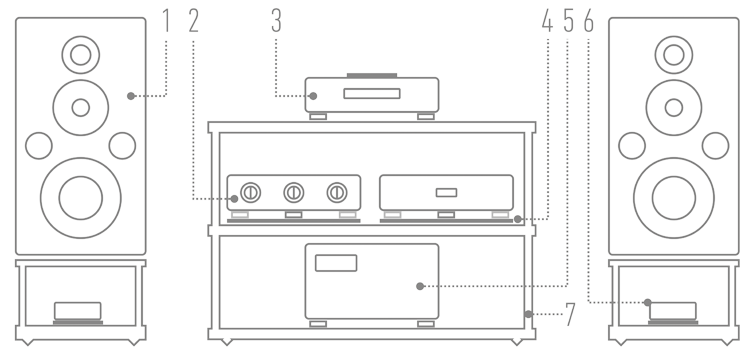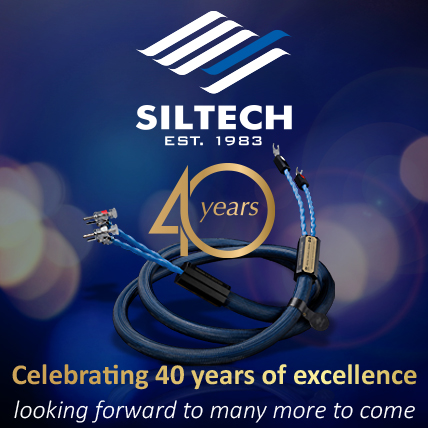|
SPEAKER CABLES Audio Phonique
Manufacturer: AUDIO PHONIQUE |

|
Review
text by WOJCIECH PACUŁA |

|
No 248 January 1, 2025 |
|
˻ PREMIERE ˼
ONE OF THE FIRST THINGS that caught my eye when I tested the first of this company's cables, the RCA Singularity interconnects in 2022, was the professional approach to the product. In the specialty industries, this is something found far too rarely, losing out to emotionally-acting appeals to commit all the money to the 'performance' of a product, without looking at the other qualities of what is referred to as a 'product'. 
In an equally positive way I perceive the second Audio Phonique cables we test in “High Fidelity”, the Desire speaker cables. The packaging alone speaks well of the manufacturer. It takes the form of a round “box” made of soft material. Unlike all the other companies that also use this idea, it's an expensive package. Nicely made, sturdy and good-looking. Which, by the way, suits this model right as the tested cable belongs to the top shelf of such products and should be treated as such, with respect. | A few simple words… ⸜ MACIEJ LENAR CONNECTIONS BETWEEN COMPONENTS are one of the most problematic and lossy elements of an audio track, involving all types of cables - interconnects, digital cables, speaker cables or power cables. The phenomena behind it are difficult to fully understand and require advanced knowledge of transmission lines and years of experience. Every cable introduces and emits interference, distorts the phase of the signal, and causes degradation of sound quality. I mean EVERY cable, without exception. There is no perfect cable, and it is physically impossible to create one. So our goal was to design cables that minimize these negative effects as much as possible. 
⸜ Mr. MACIEJ LENAR with Desire Since the company's inception six years ago, we have conducted intensive research into conductive materials, insulators, and connectors. Theoretically, we could write “doctorates” on these issues, but each new design, although based on a solid theoretical foundation, requires practical testing in various hardware configurations, which often results in the need for corrections, re-tuning, breaking-in, and so on. Prototyping is a time-consuming, expensive, and resource-intensive process, especially when using silver as the main conductive material. 
We use ultra-high purity 5N silver, obtained from repeatedly refined granules. In a continuous process, we cast a monocrystal, which is then subjected to pulling, advanced heat treatment and polishing, resulting in conductors with exceptional softness and surface smoothness. Although the costs associated with producing this material are very high, its quality justifies this approach. Our silver is called PLMAg-5N. In addition, we use 7N monocrystalline copper in our cables, polished and protected with a special low dielectric constant varnish. This copper, which is manufactured specifically for us, is called PLMCu-7N. The DESIRE series of cables is based on a hybrid of copper and silver conductors. Silver is the main conductor with a large cross-section, and copper is used as a complementary element. We have developed a unique combination that combines the transparency of silver with the abundance and warmth of copper's sound. The quality of the conductors is a key element of success, accounting for 50-70% of the final result. To ensure the best possible signal quality, our cables use air as a dielectric and high-purity medical-grade Teflon, as well as advanced shielding to protect against interference. We call our topological solutions Air Geometry (AG) for the SINGULARITY series and Extended Air Geometry (EAG) for the DESIRE series. The infographic shows a cross-section of DESIRE series cables. 
Each of our cables is handmade, from scratch. For example, having all the necessary materials at hand it still takes as many as 50 working hours to make one pair of DESIRE series speaker cables. ML ▌ Desire SP WHILE THIS IS THE SECOND CABLE from this company tested in our magazine, Audio Phonique is really a brand focused on electronics. Concentrated in two series, Classic and Statement Line, with an AC power conditioner rounding out the offer, it is the core of the lineup and all the cables are a kind of complementary components. However, looking first at the Singularity series cable, and now the more expensive Desire, we will come to the conclusion that it may be a complementary product, but still - somehow - an equivalent one to the ‘basic’ products. For the speaker cable in question this time looks great. It is nicely made, and high-quality components and materials were used in its production. And a lot of time has been devoted to it. As we read on the manufacturer's website, which was also mentioned by Mr. Maciej, each cable requires fifty hours of manual labor:
The Desire speaker cables have a sizable diameter, similar to that seen in the Siltech Triple Crown cables I use every day. I assume that it is primarily a matter of creating the right conditions for the conductors, both in terms of topology and vibration damping. Triboelectric noise, generated in cables by vibrations, caused both by external conditions and by the current flowing through the conductors, is one of the most difficult to eliminate. And it is responsible for masking signals of ultra-low amplitudes. The manufacturer declares that the conductors in the Desire series cables, and it includes analog interconnects, speaker cables and an AC power cable, are placed in a dielectric of Teflon and air. So it appears that these are multi-litz cables with wires inserted into Teflon tubes of considerable diameter - hence the air. The company called this solution Extended Air Geometry (EAG). As it assures, up to 90% of the wires' surfaces have air around them. 
The Desire series models are constructed with two types of conductor. These are wires made of, as we read, “ultra-pure silver” and “ultra-pure copper.” Their company names read: PLMAg-5N for silver and PLMCu-7N for copper. A tab titled Technologies reads (the manufacturer has a website in English only, which is a good indication of its target customer group):
The copper, too, is made in-house, or rather, it seems, by a third-party manufacturer, but under the regime specified by Audio Phonique. It is 7N pure OCC copper (Ohno Contonous Casting, 99.99999%), polished and coated with lacquer. Polishing helps the high-frequency signal flow undisturbed, and this treatment is used by all major cabling manufacturers, mainly from Japan. The varnishing, in turn, is, I believe, to prevent the cable from oxidizing. |
From the drawings shown on the manufacturer's website, it appears that the Desire speaker cable is constructed from six separate bundles. Each is housed in a separate tube, and includes four wires and the core around which they are wrapped. In turn, on top of all that comes a tight, braided shield, covering the cable in its entirety. And it is it, with its golden color, that shines through from under the black mesh. At the end of the thicker sections, the place where the vibration damping system ends, the cables are joined into two gears. The place is capped with very nicely crafted wood elements. This is a decorative element, but it also plays an important role in shaping the sound of the cable. Just a few years ago this might have seemed absurd to a layman, but today it is confirmed by virtually all manufacturers I have talked to about it. The cables are terminated with Furutech FT-211 G connectors. These are made of gold-plated copper in the form of spades. The manufacturer believes that spades are the best way to connect cables and speaker terminals. However, it also offers a version with bananas upon request. Desire speaker cables are available in any length (upon request), with the basic ones being: 2, 2.5, 3 m, etc. ▌ SOUND HOW WE LISTENED • Audio Phonique Desire cables were tested in a HIGH FIDELITY reference system. It was compared to my reference cables, i.e. Siltech Triple Crown. The cables connected the output of a Solution 710 power amplifier and the input of Harbeth M40.1 speakers, and rested on Acoustic Revive RCI-3H stands; more → HERE ˻PL˺. 
It was an AA/BB/A and BB/AA/B comparison with A and B known. I used music pieces lasting 1 to 2 minutes. Switching the cables each time took around 40 seconds. » ALBUMS USED FOR THE TEST ⸜ a selection
⸜ TAMINO, Babylon,Communion Group/Tidal, SP, FLAC 16/48 (2024). I DON'T KNOW WHETHER THIS IS a structural change, or opportunism, or whether manufacturers are sending products to test in “High Fidelity” that meet my requirements. Or maybe it's just that it’s all in my imagination, and there really has been some kind of good transformation in audio. The thing is, the Audio Phonique Desire cable is another product in the last year that I've been auditioning in my system that has that “something” in the sound that makes me no longer listen so carefully to what this cable cannot do, focusing instead on its strengths. 
However, let's start with the former, as it will be easier to understand why this is such an excellent link. Desire is not as resolving as the reference cable, the Siltech Triple Crown. The difference between the two is not particularly big, but it is there. Looking at the price jump between the two, you could say it's negligible. But, to reiterate, it is there. It's about a slight smoothing of the edges, a slight zooming on the back of the stage, a little less energy within the bodies and things like that. The cable extends beautifully in the bass range, this range is meaty and deeply saturated with it. At the very bottom, reached in the 1 Babylon track by one of my favorite performers, TAMINO, or in OCHMAN’s 1 Siłacz, another favorite of mine, there it slightly “lets it go”. This is a tight and well-controlled bass, to be clear. Other cables can usually dream of something like this. In direct comparison with the objective reference, you can hear that some of its lowest range is slightly extended, as if the idea is to squeeze some more juice out of the lows, to play with them a little longer. These are all the sins I can remember :) Because apart from that, Audio Phonique are simply fantastic speaker cables. I would describe its timbre as extremely natural. In the sense that it is devoid of artificial hardening of the attack, but also with a filling that is associated, to refer to stereotypes, with the sound of a tube amplifier and vinyl. When MELODY GARDOT sings in 24 La Llorna – Live, her voice is dark and velvety - the kind I know from my system. The cello, on the other hand, was a bit distant, as were the percussion instruments, which you hear some of the time. It is not throwing the sound “in the face”. And yet the foreground is quite close to us, if that's how the manufacturer thought of it. Interesting, but the Siltechs go a step further in this, as they present three-dimensional bodies half a step closer to the listening position. Audio Phonique, however, has a slightly different approach to the background, and perhaps this causes the phanstom images to be shaped a bit differently with it, despite the similar tone. They are creamy. Both in terms of timbre, dynamics and shaping of bodies. That's why all the vocals I cited above had a kind of inner softness to them. Their microdynamics were excellent, it was clear, differentiated presentation. And yet the attack of the sound was gently smoothed, as if flecked with gold. This caused, on the one hand, this gentle receding of the sound into the soundstage, despite the fact that it is an organically warm, natural presentation. Not “warmed up”, but natural. This density, this velvetness, this fleshyness, it all translates into a very good presentation of space. It is not something like sounds suspended in a vacuum, but a dense “carpet” in which three-dimensional events are embedded. Their three-dimensionality lies in the fact that they are perfectly legible. They have a softness to them, that's clear, but they are also tangible and wonderfully defined in relation to each other. That's why, when the first sounds of the synthesizer starting KOMBI’s ˻ 7 ˺ Słodkiego miłego życia, on SACD, with material remastered by Damian Lipinski, ring out, it's something almost real. Skawinski's vocal, which enters after some time, has been given a phase shift by the sound engineer, making it seem spacious. It's also noticeably brighter than the background, which Damian didn't put out. Desire slightly toned down this brightness. It didn't close it in, it's a cable open to any upper range information. But information, not distortion. It's as if it filtered out the artifacts that make recordings unpleasant to listen to. The Kombi album is not like that, it is excellent. But it was with the vocals that the Audio Phonique cable showed that it goes in the direction of pleasant, trouble-free playing, if you will. This is a very good direction. Because, after all, it is a very resolving cable. It's not particularly selective, preferring larger presumptions to fine details. But after all, when, in the sequence that begins SANTANA’S ˻ 1 ˺ Waiting, the first track from his debut album, the sound engineer at some point opens the mixer fader with the “overhead” microphone, i.e., positioned above the cymbals, slightly off the top, in the left channel, and this shift in the sound of the hi-hats can be heard perfectly. The whole track sounded dynamic and explosive, But also silky. This is a special feature of this cable. And if anyone would still invoke the stereotype of “silver” as a bright and jazzy metal, they should listen - not even to Siltech or Crystal Cable, because that's obvious - but just to Desire. It offers an incredible flow of music. The chorus vocals in ˻ 2 ˺ Evil Ways, spread across the channels, were superbly embedded in the mix, backed by drums and percussion instruments. And the Hammond organ entering at 1:24, shown here as dense and dark, opened the whole thing up timbrally. As for dynamics, I would recommend caution in forming an opinion based on a short listening session. After all, in a quick demo the tested cable will seem calm. Not even calm, but just that - “gentlemanly”. In fact, dynamics is one of its more important strengths. Let's listen to the beginning of ˻ 1 ˺ Lonely Woman from ORNETTE COLLEMAN's The Shape of Jazz to Come album. After relatively quiet monophonic percussion and double bass at 0:16, they explode in both channels - Donald Cherry's cornet and the leader's alto saxophone. And this outburst is just perfectly marked by Desire. But not as an artifact, but a sudden, dynamic entrance of loud instruments. ▌ Summary AND THAT IS EXACTLY WHAT DESIRE IS. It's an excellent, high-end cable that offers resolution, dynamics and space at a very high level. Its tonality goes in the direction of warmth, but it doesn't get there. It can be said of it that it is not “expressive”, because it does not promote the attack of the sound, but its filling. But to all the details I've already mentioned I should add the sounds of the audience from 1 My Foolish Heart, the opening track of the BILL EVANS TRIO’S Waltz For Debby album where all these things were more than just clear, because that's obvious, but they were a natural extension of the music. 
It's a cable that has its tonal balance set low, and thus plays with strong and saturated bass. It goes deep and almost to the very bottom is energetic. There it is gently extended, but this does not blur the edges, but adds weight to the whole. This is a cable that allows you to experience music perfectly, in completely calmly fashion and good mood. This really is something one will appreciate. ● 
THIS TEST HAS BEEN DESIGNED ACCORDING TO THE GUIDELINES adopted by the Association of International Audiophile Publications, an international audio press association concerned with ethical and professional standards in our industry, of which HIGH FIDELITY is a founding member. More about the association and its constituent titles → HERE. |

|
Reference system 2024 |
|
 1) Loudspeakers: HARBETH M40.1 |REVIEW| 2) Line preamplifier: AYON AUDIO Spheris III Linestage |REVIEW| 3) Super Audio CD Player: AYON AUDIO CD-35 HF Edition No. 01/50 |REVIEW| 4) Stands (loudspeakers): ACOUSTIC REVIVE (custom) |ABOUT| 5) Power amplifier: SOULUTION 710 6) Loudspeaker filter: SPEC REAL-SOUND PROCESSOR RSP-AZ9EX (prototype) |REVIEW| 7) Hi-Fi rack: Hi-Fi rack: finite elemente MASTER REFERENCE PAGODE EDITION Mk II, more → HERE |
|

|
Cables Analog interconnect SACD Player - Line preamplifier: SILTECH Triple Crown (1 m) |ABOUT|» ANALOG INTERCONNECT Line preamplifier → Power amplifier: Siltech ROYAL SINLGE CROWN RCA; review → HERE Speaker cable: SILTECH Triple Crown (2.5 m) |ABOUT| |

|
AC Power Power cable | Mains Power Distribution Block - SACD Player: SILTECH Triple CrownPower (2 m) |ARTICLE| » POWER CABLE Mains Power Distribution Block → Line preamplifier: Acoustic Revive ABSOLUTE-POWER CORD, review → HERE » POWER CABLE Mains Power Distribution Block → Power amplifier: Acoustic Revive ABSOLUTE-POWER CORD, review → HERE Power cable | Power Receptacle - Mains Power Distribution Block: ACROLINK Mexcel 7N-PC9500 (2 m) |ARTICLE| Power Receptacle: Acoustic Revive RTP-4eu ULTIMATE |REVIEW| » ANTI-VIBRATION PLATFORM under Acoustic Revive RTP-4eu ULTIMATE: Graphite Audio CLASSIC 100 ULTRA, review → HERE Power Supply Conditioner: Acoustic Revive RPC-1 |REVIEW| Power Supply Conditioner: Acoustic Revive RAS-14 Triple-C |REVIEW| Passive filter EMI/RFI: VERICTUM Block |REVIEW| |

|
Anti-vibration Speaker stands: ACOUSTIC REVIVE (custom)Hi-Fi rack: finite elemente MASTER REFERENCE PAGODE EDITION Mk II, more → HERE Anti-vibration platforms: ACOUSTIC REVIVE RAF-48H |ARTICLE| » ANTI-VIBRATIONAL FEET: |

|
Analogue Phono preamplifier: Phono cartridges:
Clamp: PATHE WINGS Titanium PW-Ti 770 | Limited Edition Record mats:
|

|
Headphones » HEADPHONE AMPLIFIER: Leben CS-600X, review → HEREHeadphones: Headphone Cables: Forza AudioWorks NOIR HYBRID HPC |
main page | archive | contact | kts
© 2009 HighFidelity, design by PikselStudio,
projektowanie stron www: Indecity
















